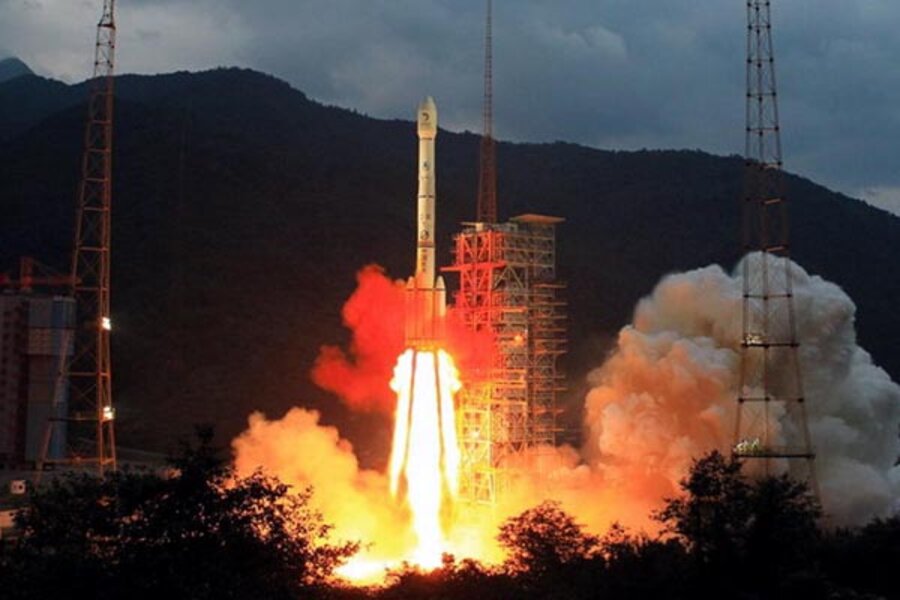China is on path to 'militarization of space'
| Taipei, Taiwan
China looks set to pull ahead in the Asian space race to the moon, putting a spacecraft into lunar orbit Oct. 6 in a preparatory mission for an unmanned moon landing in two or three years.
Chinese engineers will maneuver the craft into an extremely low orbit, 9.5 miles above the moon's surface, so it can take high-resolution photos of a possible landing site.
Basically, China is looking for a good "parking space" for a moon lander, in a less-known area of the moon known as the Bay of Rainbows.
The mission, called Chang'e 2 after a heroine from Chinese folklore who goes to the moon with a rabbit, highlights China's rapidly growing technological prowess, as well as its keen desire for prestige on the world stage. If successful, it will put China a nose ahead of its Asian rivals with similar lunar ambitions – India and Japan – and signal a challenge to the American post-cold-war domination in space.
The Asian space race
Compared with the American and Soviet mad dashes into space in the late 1950s and '60s, Asia is taking its time – running a marathon, not a sprint. "All of these countries witnessed the cold war, and what led to the destruction of the USSR," says Ajey Lele, an expert on Asian space programs at the Institute for Defense Studies and Analysis in New Delhi, referring to the military and space spending that helped hasten the decline of the Soviet regime. "They understand the value of money and investment, and they are going as per the pace which they can go." But he acknowledged China's edge over India. "They started earlier, and they're ahead of us at this time," he says.
India put the Chandrayaan 1 spacecraft into lunar orbit in 2008, a mission with a NASA payload that helped confirm the presence of water on the moon. It plans a moon landing in a few years' time, and a manned mission as early as 2020 – roughly the same timetable as China.
Japan is also mulling a moonshot, and has branched out into other space exploration, such as the recent Hayabusa mission to an asteroid. Its last lunar orbiter shared the moon with China's first in 2007.
Both Japan's and India's recent missions have been plagued by glitches and technical problems, however, while China's have gone relatively smoothly.
Mr. Lele said the most significant aspect of the Chang'e 2 mission was the attempt at a 9.5-mile-high orbit, a difficult feat. India's own lunar orbiter descended to about 60 miles in 2008, he said, but was forced to return to a more stable, 125-mile-high orbit.
A low orbit will allow for better scouting of future landing sites, said Lele. "They [the Chinese] will require huge amounts of data on landing grounds," said Lele. "A moon landing hasn't been attempted since the cold war."
During the famed 1969 Apollo 11 manned mission to the moon, astronaut Neil Armstrong had to take control of the lander in the last moments of descent to avoid large moon boulders strewn around the landing site. China hopes to avoid any such last-minute surprises with better reconnaissance photos, which would allow them to see moon features such as rocks as small as one-meter across, according to Chinese media.
Is China's space exploration a military strategy?
Meanwhile, some have pointed out that China's moonshot, like all space programs, has valuable potential military offshoots. China's space program is controlled by the People's Liberation Army (PLA), which is steadily gaining experience in remote communication and measurement, missile technology, and antisatellite warfare through missions like Chang'e 2.
The security implications of China's space program are not lost on India, Japan, or the United States.
The Pentagon notes that China, through its space program, is exploring ways to exploit the US military's dependence on space in a conflict scenario – for example, knocking out US satellites in the opening hours of a crisis over Taiwan.
"China is developing the ability to attack an adversary's space assets, accelerating the militarization of space," the Pentagon said in its latest annual report to Congress on China's military power. "PLA writings emphasize the necessity of 'destroying, damaging, and interfering with the enemy's reconnaissance ... and communications satellites.' "
More broadly, some in the US see China's moon program as evidence that it has a long-range strategic view that's lacking in Washington. The US has a reconnaissance satellite in lunar orbit now, but President Obama appears to have put off the notion of a manned return to the moon.
With China slowly but surely laying the groundwork for a long-term lunar presence, some fear the US may one day find itself lapped –"like the tale of the tortoise and the hare," says Dean Cheng, an expert on China's space program at the Heritage Foundation in Washington. "I have to wonder whether the United States, concerned with far more terrestrial issues, and with its budget constraints, is going to decide to make similarly persistent investments to sustain its lead in space."





